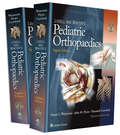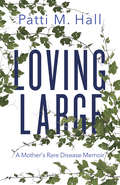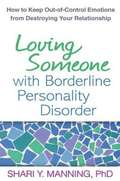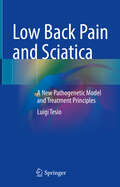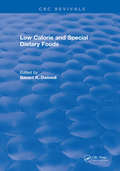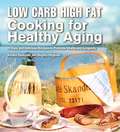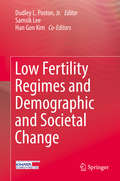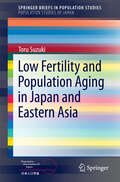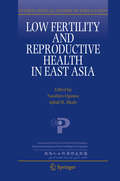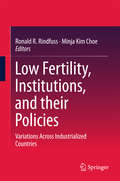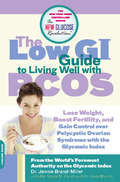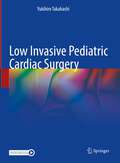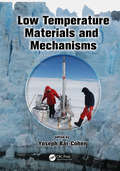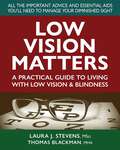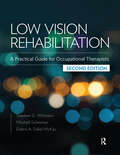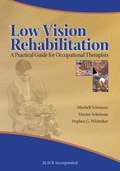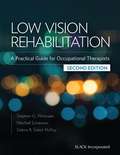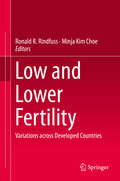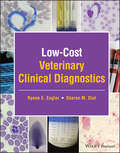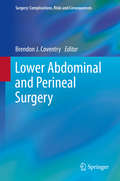- Table View
- List View
Lovell and Winter's Pediatric Orthopaedics
by John M. Flynn Stuart WeinsteinThe gold standard comprehensive reference in pediatric orthopaedics is a must-have resource for physicians and residents treating infants, children, and adolescents with orthopaedic problems. Lovell and Winter’s Pediatric Orthopaedics, 8th Edition, brings you fully up to date in the field with new content, a new editor, and many new contributing authors who cover all aspects of basic science, clinical manifestations, and management. You’ll find complete, expert coverage of normal musculoskeletal development and the causes, diagnosis, and treatment of the entire range of abnormalities, with emphasis on evidence-based decision making in treatment selection.
Lovie: The Story of a Southern Midwife and an Unlikely Friendship (Documentary Arts and Culture, Published in association with the Center for Documentary Studies at Duke University)
by Lisa YargerFrom 1950 to 2001, Lovie Beard Shelton practiced midwifery in eastern North Carolina homes, delivering some 4,000 babies to black, white, Mennonite, and hippie women; to those too poor to afford a hospital birth; and to a few rich enough to have any kind of delivery they pleased. Her life, which was about giving life, was conspicuously marked by loss, including the untimely death of her husband and the murder of her son.Lovie is a provocative chronicle of Shelton's life and work, which spanned enormous changes in midwifery and in the ways women give birth. In this artful exploration of documentary fieldwork, Lisa Yarger confronts the choices involved in producing an authentic portrait of a woman who is at once loner and self-styled folk hero. Fully embracing the difficulties of telling a true story, Yarger is able to get at the story of telling the story. As Lovie describes her calling, we meet a woman who sees herself working in partnership with God and who must wrestle with the question of what happens when a woman who has devoted her life to service, to doing God's work, ages out of usefulness. When I'm no longer a midwife, who am I? Facing retirement and a host of health issues, Lovie attempts to fit together the jagged pieces of her life as she prepares for one final home birth.
Loving Large: A Mother's Rare Disease Memoir
by Patti M. HallIf not me, then who will save my child? A mother must confront the unthinkable when her son is diagnosed with a rare medical condition. Patti M. Hall’s life is pitched into an abyss of uncertainty when a golf ball–sized tumour is discovered in her teenage son’s head and he is diagnosed with gigantism, a disease of both legend and stigma. After scrambling to access a handful of medical experts in the field, Patti learns that her son could grow uncontrollably, his mobility could be permanently limited, and his life could be cut short without timely and aggressive treatment. Patti’s attention shifts fully to her son, away from her relationships as well as her own career and health. Her new normal sees her step into a dozen additional roles, including nurse, researcher, advocate, risk assessor, and promise maker, while she struggles and fails to rebuild her life as a recently divorced woman. In Loving Large, Patti discovers that resilience is learned and that the changes experienced in the aftermath of crisis can often create the greatest opportunities.
Loving Someone with Borderline Personality Disorder
by Shari ManningPeople with borderline personality disorder (BPD) can be intensely caring, warm, smart, and funny but their behavior often drives away those closest to them. If you're struggling in a tumultuous relationship with someone with BPD, this is the book for you. Dr. Shari Manning helps you understand why your spouse, family member, or friend has such out-of-control emotions and how to change the way you can respond. Learn to use simple yet powerful strategies that can defuse crises, establish better boundaries, and radically transform your relationship. Empathic, hopeful, and science based, this is the first book for family and friends grounded in dialectical behavior therapy (DBT), the most effective treatment for BPD.
Loving Someone with Borderline Personality Disorder: How to Keep Out-of-Control Emotions from Destroying Your Relationship
by Marsha M. Linehan Shari Y. ManningPeople with borderline personality disorder (BPD) can be intensely caring, warm, smart, and funny-but their behavior often drives away those closest to them. If you're struggling in a tumultuous relationship with someone with BPD, this is the book for you. Dr. Shari Manning helps you understand why your spouse, family member, or friend has such out-of-control emotions-and how to change the way you can respond. Learn to use simple yet powerful strategies that can defuse crises, establish better boundaries, and radically transform your relationship. Empathic, hopeful, and science based, this is the first book for family and friends grounded in dialectical behavior therapy (DBT), the most effective treatment for BPD.
Low Back Pain and Sciatica: A New Pathogenetic Model and Treatment Principles
by Luigi TesioChronic benign “back pain “, with or without sciatica, is a descriptive diagnosis hiding the mechanisms leading to this symptom. The literature still refers to it as a “non-specific” disease. Not surprisingly, both conservative and invasive treatments are inconsistent and highly subjective. The book aims to highlight the main pathogenetic mechanisms leading to pain based on a thorough analysis of the lumbar spine anatomy and mechanics (including its vascular content) and a selection of published evidence converging towards an original integrated model. The result is a downgrading of back pain from a “non-specific” disease to a symptom and clarifying the underlying causes. The book presents an original pathogenetic model named CoVIn (Compressive-Venous-Inflammatory). The cornerstones of the model are a) the compression of nerve endings within the narrow spinal canal from disc herniation or arthritic spurs, b) local inflammation caused by discal material and/or local phlebitis and -most importantly- c) venous congestion of the Batson (epidural) plexus. The model explains the diversity of the clinical pictures: e.g., pain at rest vs. pain during spinal loading; pain unrelated to the severity of MRI or CT imaging; changes of pain (spontaneous or caused by treatments) with no changes in imaging, and others. Consistent with the model, a few physiotherapy treatments are proposed to widen the spinal canal and decongest local veins. These are “flexor” lumbar exercises, water exercises, and—first choice—Active Lumbar Traction (former “Autotraction”). Treatments targeting pain become a second-choice approach. Surgery is shown to be rational only after conservative treatments fail. Other rare causes of back pain, unrelated to the CoVin model, are overviewed and discussed. The book will interest Physical Medicine and Rehabilitation Physicians, Physiotherapists, Orthopedic and Trauma Surgeons, Neurosurgeons, Rheumatologists, Neurologists, and Family physicians.
Low Calorie and Special Dietary Foods
by B.K. DwivediThis book is based on the papers presented at the Symposium on Low Calorie and Special Dietary Foods at the annual meeting of the Institute of Food Technologies in Anaheim California on June 8, 1976.
Low Carb High Fat Cooking for Healthy Aging: 70 Easy and Delicious Recipes to Promote Vitality and Longevity
by Birgitta Hoglund Annika DahlqvistOftentimes, the so-called diseases of affluence, like diabetes or high blood pressure, are due to improper diet as you age. By eating food with fewer carbohydrates and more fat, you can maintain a normal weight and become free of the symptoms of, for example, fibromyalgia, irritable bowel syndrome (enteritis), chronic fatigue syndrome, and sleep disorders. Low Carb High Fat Cooking for Seniors contains over 70 easy-to-prepare recipes for those who want hearty and nutritious food that makes you feel as good as possible. Recipes center around healthy, Low Carb High Fat (LCHF) staple ingredients, like butter, cream, crème fraîche, eggs, coconut oil, olive oil or canola oil (cold pressed), nuts and almonds, and cheese, and are suitable as breakfast, snacks, entire meals, or tidbits at teatime. Recipes include: Almond Waffles Buckwheat Porridge Spinach Soup with Bacon Salmon and Cauliflower Casserole Lingonberry Ice Cream Chocolate-Covered Macaroons An much more! Birgitta Höglund is a trained chef and has long posted on her popular blog, Birgitta Höglund’s Food (Birgitta Höglund’s Mat). She has personal experience following an LCHF diet, and her LCHF recipes in this book are also crafted for the Glycemic Index (GI) and Paleo diets. Many people simply prefer to eat natural food without preservatives, and Low Carb High Fat Cooking for Seniors is here to provide tasty, simple-to-prepare food that’s healthy for seniors as well as the whole family.
Low Energy Particle Accelerator-Based Technologies and Their Applications
by Vlado ValkovićLow Energy Particle Accelerator-Based Technologies and Their Applications describes types of low energy accelerators, presents some of the main manufacturers, illustrates some of the accelerator laboratories around the globe and shows examples of successful transfers of accelerators to needed laboratories. Key Features: Presents new trends and the state of the art in a field that's growing Provides an overview of numerous applications of such accelerators in medicine, industry, earth sciences, nuclear non-proliferation and oil Fills a gap, with the author drawing on his own experiences with transporting such relatively large machines from one lab to the other that require a tremendous amount of planning, technical and engineering efforts This is an essential reference for advanced students as well as for physicists, engineers and practitioners in accelerator science. About the Author Dr. Vladivoj (Vlado) Valković, a retired professor of physics, is a fellow of the American Physical Society and Institute of Physics (London). He has authored 22 books (from Trace Elements, Taylor & Francis, 1975, to Radioactivity in the Environment, Elsevier, 1st Edition 2001, 2nd Edition 2019), and more than 400 scientific and technical papers in the research areas of nuclear physics, applications of nuclear techniques to trace element analysis in biology, medicine and environmental research. He has lifelong experience in the study of nuclear reactions induced by 14 MeV neutrons. This research has been done through coordination and works on many national and international projects, including US-Croatia bilateral, NATO, IAEA, EU-FP5, FP6 and FP7 projects. Cover photo credit: 3SDH 1 MV Pelletron system with RF source and analysis endstation designed with the intended purpose of aiding in fusion research. It is capable of Ion Beam Analysis (IBA) techniques such as RBS, ERD, PIXE and NRA. Further detectors could be added to the endstation to allow for other techniques. Installed in Japan in 2014. Courtesy of National Electrostatics Corp.
Low Fertility Regimes and Demographic and Societal Change
by Jr. Dudley L. PostonThis book explores how low fertility levels could fundamentally change a country's population and society. It analyzes the profound effects below average birthrates have on virtually all aspects of society, from the economy to religion, from marriage to gender roles. An introduction written by Dudley L. Poston Jr. provides a general overview of this relatively new phenomenon that has already impacted nearly one-half of the countries of the world today. Poston also discusses the broad implications of the changes that these societies are currently experiencing and the ones that they will soon confront. Next, each of the 12 essays collected in this volume look into how a low fertility level affects a particular demographic or societal structure or process. In addition, case studies offer an in-depth portrait of these changes in the United States and China. Coverage includes the dynamics of low and lowest-low (where the birthrate is well below average) fertility, high and increasing life expectancies in the United States, the implications of native-born fertility and other socio-demographic changes for less-skilled U. S. immigration, ageing and age dependency in post-industrial societies, good mothering and gender roles in China, the increasing prevalence of voluntary childlessness, how low fertility and prolonged longevity could result in slow economic growth, the decreasing relevance of traditional religious systems, and more. The emergence and persistence of population decline produced by low fertility levels has the potential to greatly alter key aspects of society as well as individual lives. Containing insightful analysis from some of the top minds in demography today, this book will arm readers with the knowledge they need to fully understand these transformations.
Low Fertility and Population Aging in Japan and Eastern Asia
by Toru SuzukiThis book provides a unique comparative view of the extremely low fertility and drastic population aging in Eastern Asian countries. After discussing demographic and political developments of Japan in detail as a reference case, accelerated changes in Korea, Taiwan and China are interpreted with a comparative cultural view. In addition to the well-known cultural divide between countries with strong and weak family ties, this book proposes another divide between offspring of the feudal family and that of the Confucian family. Included is a discussion of how the discrepancy between the compressed change in the socioeconomic system and the slow change in the family system has resulted in extremely low fertility in Eastern Asia. A comparison of policy development reveals that the sense of overpopulation has caused difficulty in launching pro-natal policy interventions in Eastern Asia, especially in China. Impacts of fertility decline on population aging, total dependency ratio and the timing of population decline in Eastern Asia are analyzed with a stylized model. The remaining Confucian family pattern is especially important in understanding and predicting political development to cope with accelerated population aging. This book is a valuable resource for researchers who are interested in the latest and most surprising demographic phenomena in the region.
Low Fertility and Reproductive Health in East Asia
by Naohiro Ogawa Iqbal H. ShahThis book provides a unique blend of social and biomedical sciences in the field of low fertility and reproductive health. It offers a significant contribution to understanding the determinants of low fertility mostly in East Asia, including an assessment of the effectiveness of policies that aim to raise fertility. It introduces new analytical tools and methods and shares application of innovative approaches to analyzing cross-sectional and longitudinal survey data and macro socioeconomic data to shed light on changing mechanisms of low fertility in the context of reproductive health. The volume introduces the demographic dividend into the study of fertility, analyzes possible impact of population ageing on the amount of resources allocated to child rearing, i. e. the so called "crowding effect" in social care and public spending between the elderly and children. The book also tests the Low Fertility Trap (LFT) hypothesis, a new important theory regarding fertility trends. The book focuses on East Asia which is numerically large but relatively under-researched with regard to issues covered in various chapters. The relevance of the volume, however, goes beyond countries in East Asia. The book breaks new grounds and reveals little known facts regarding the influence of endocrine disruptors on male fertility through falling sperm counts, the phenomenon of marital sexlessness and about the sexual behavior of adolescents in East Asia.
Low Fertility, Institutions, and their Policies
by Ronald R. Rindfuss Minja Kim ChoeThis volume examines teneconomically advanced countries in Europe and Asia that have experienceddifferent levels of fertility decline. It offers readers a cross-countryperspective on the causes and consequences of low birth rates and the differentpolicy responses to this worrying trend. The countries examinedare not only diverse geographically, historically, and culturally, but alsohave different policies and institutions in place. They include sixvery-low-fertility countries (Austria, Czech Republic, Hungary, Italy, Spain,and Taiwan) and four that have close to replacement-level fertility (UnitedKingdom, Norway, Canada, and France). Although fertility hasgone down in all these countries over the past 50 years, the chapters examinethe institutional, policy, and cultural factors that have led some countries tohave much lower fertility rates than others. In addition, the final chapterprovides a cross-country comparison of individual perceptions about obstaclesto fertility, based on survey data, and government support for families. Thisbroad overview, along with a general introduction, helps put the specificcountry papers in context. As birth rates continueto decline, there is increasing concern about the fate of social welfaresystems, including healthcare and programs for the elderly. This book will helpreaders to better understand the root causes of such problems with itsinsightful discussion on how a country's institutions, policies, and cultureshape fertility trends and levels.
Low GI Guide to Living Well with PCOS
by Jennie Brand-Miller Dr Nadir R. Farid Dr Kate MarshThe Only Book You Will Ever Need for Managing PCOS--Completely Revised and Updated What exactly is PCOS? What are the signs and symptoms? How is the diagnosis confirmed? What causes it? And most importantly, what can you do about it? If you've been diagnosed with polycystic ovarian syndrome (PCOS) or suspect you have it, and you're looking for a way to manage your condition, you've come to the right place. In this newly revised edition of Living Well with PCOS, Dr. Jennie Brand-Miller and PCOS experts Drs. Nadir Farid and Kate Marsh address the root cause of PCOS--insulin resistance--and show you how eating a low-GI diet can help alleviate even your most troublesome symptoms, including weight gain, infertility, unsightly hair growth, irregular cycles, and fatigue. This all-new second edition features: The latest up-to-date research on PCOS and its treatment New quick-and-easy low-GI recipes Low-GI kick-start menus--with vegetarian and gluten-free options Easy-to-use tables of GI values Tips for a more active lifestyle Real-life stories from women who have used the GI to successfully combat PCOS
Low Invasive Pediatric Cardiac Surgery
by Yukihiro TakahashiThis book demonstrates the significance of minimally invasive extracorporeal circulation and reduced time as two of the most important factors for pediatric cardiac surgery and early postoperative recovery. The content is divided into three major thematic sections: low invasiveness; pitfalls and countermeasures before, during and after operations; and suggestions on time-saving and team building. Abundant figures aid in comprehension, while videos of the surgery offer practical insights for readers at all levels. Advances in extracorporeal circulation devices and management have led to new clinical problems such as decreased perfusion pressure, high pressures in oxygenators, and changes in acid-base equilibrium. The book explains these problems both clinically and experimentally, and describes countermeasures. Low Invasive Pediatric Cardiac Surgery provides valuable evidence and practical suggestions for all surgeons, perfusionists, scrub-nurses, and anesthesiologists who are engaged in pediatric cardiac surgery. It will also appeal to pediatric cardiologists and medical device manufacturers. The book is intended to share the author’s experience and actual data with readers who have clinical experience, and to help prepare beginners.
Low Temperature Materials and Mechanisms
by Yoseph Bar CohenThis book addresses the growing interest in low temperature technologies. Since the subject of low temperature materials and mechanisms is multidisciplinary, the chapters reflect the broadest possible perspective of the field. Leading experts in the specific subject area address the various related science and engineering chemistry, material science, electrical engineering, mechanical engineering, metallurgy, and physics.
Low Vision Matters
by Laura Stevens, MSci Thomas BlackmanAccordingto the Centers for Disease Control and Prevention (CDC), over seven millionpeople in the US alone suffer from severe vision loss or blindness. In thepast, low vision was truly a life-altering condition. Those seemingly everydaytasks that were once so simple instead became difficult—whether one had towork, cook, read, drive, go out to shop, or even turn on a light switch, one&’sworld had been completely turned upside down. Today, however, things havebegun to change. With the revolution of Artificial Intelligence (AI) alreadyunderway, many of the major barriers caused by diminished or fully lost visionhave been lessened or completely eliminated. In Low Vision Matters, authors Laura Stevens and Thomas Blackmanprovide a comprehensive guide to all the aids and equipment now available—alongwith important practical advice—to those who are vision-challenged.Thebook is divided into two parts. Part One focuses on the day-to-day activitiesthat low vision can affect—from safety in your home or traveling outside, tothe handling of finances or one&’s home entertainment system. It discusses thelatest technologies that can enable a person with eyesight problems toturn on a light, start a dishwasher, or even answer a phone through the use oforal commands—and that&’s just the tip of the iceberg. Part Two then provides abreakdown of the various kinds of helpful vision-aid products now available.Because the authors understand the costs involved in purchasing such equipment,they include the names of those organizations and associations in an extensiveResources section along with various other crucial contacts about which thosewith low vision and their loved ones and caretakers need to know.Timeshave changed. Low Vision Mattersprovides a wealth of information that can vastlyimprove the daily life of a person living with vision loss or blindness.
Low Vision Rehabilitation: A Practical Guide for Occupational Therapists
by Mitchell Scheiman Stephen Whittaker Debra Sokol-McKayThis Second Edition of Low Vision Rehabilitation: A Practical Guide for Occupational Therapists provides current, evidence-based information on low vision rehabilitation that contains several new and expanded chapters on ADLs, IADLs, and recreation, as well as new online resources and the latest in accessibility devices.Low vision rehabilitation is rapidly growing as a specialty practice for occupational therapists. This growth requires practical, evidence-based information on the evaluation and treatment of the effects of low vision on occupational performance. Responding to this need, Low Vision Rehabilitation: A Practical Guide for Occupational Therapists, Second Edition blends standards of practice that have been developed for over 50 years by low vision therapists and optometrists, with the latest scientific research and the unique perspective of occupational therapists.This text is written to introduce the student and general practitioner to low vision rehabilitation as commonly encountered in medical rehabilitation as well as provides a conceptual approach to evaluation and treatment that will enrich an advanced practice. Authors Stephen Whittaker, a low vision researcher, certified low vision therapist and occupational therapist, Mitchell Scheiman, an optometrist and researcher, and Debra Sokol-McKay, an occupational therapist with specialty certification in low vision as well as certification as a low vision therapist, vision rehabilitation therapist and diabetes educator, have carefully selected evidence-based evaluations and treatments that focus on clinical practicality and meaningful occupational goals in adults.New to the Second Edition: A focus on occupational performance using “whatever works,” whether visual, non-visual, or a combination of these different devices and adaptive techniques The “EPIC” Framework, a general strategy to organize a treatment plan for daily activities using visual and non-visual techniques Access to a companion website designed as a handy clinical reference, with solutions to clinical problems easily searchable and cross-linked to related content The “Success-Oriented Approach” to interventions based on the most recent research on cognitive disability and depression associated with low vision Applications of the latest electronic accessibility devices including smartphones, tablets, and magnifiers that read aloud Incorporates the AADE™ 7 Self-Care Behavior framework of the American Association of Diabetes Educators Incorporates concepts from the latest edition of the AOTA Occupational Therapy Practice Framework: Domain and Process A chapter devoted to field loss, spatial neglect and perceptual impairments resulting from acquired-brain-injury. The latest in Medicare documentation standards including outcome to G-code conversions and ICD-10 diagnostic coding for low vision. Included with the text are online supplemental materials for faculty use in the classroom.Features Included: Recommended practical evaluation and treatment methods such as a 1 hour evaluation protocol, how to write observable and measurable goals and document outcomes, and specific instructions on how to implement treatments Prepares therapists for the ACVREP certification as a low vision therapist or vision rehabilitation or AOTA specialty certification in low vision Emphasizes intervention and low vision rehabilitation treatment including: modification of the environment adaptive visual and non-visual techniques selection and use of non-optical assistive devices selection and use of electronic and optical devices and use of computer technology including smartphones and tablets Comprehensive case studies on vision impairment resulting from eye disease to head injury and more Provides valuable in
Low Vision Rehabilitation: A Practical Guide for Occupational Therapists
by Mitchell Scheiman Maxine Scheiman Stephen G. WhittakerLow vision rehabilitation is rapidly growing as a specialty practice for occupational therapists. This growth requires practical, evidence-based information on the evaluation and treatment of the effects of low vision on occupational performance. Responding to this need, Low Vision Rehabilitation: A Practical Guide for Occupational Therapists blends standards of practice that have been developed over 50 years by low vision therapists and optometrists, with the latest scientific research and the unique perspective of occupational therapists. Low Vision Rehabilitation presents an emerging model in which occupational therapists practice as part of a team of vision rehabilitation professionals serving adults with low vision. Occupational therapists offer a unique contribution to the vision rehabilitation team, with a focus on meaningful occupational goals, the incorporation of occupation into therapy, and the orchestration of environmental, social, and non-visual personal factors into a treatment plan. Mitchell Scheiman, Maxine Scheiman, and Stephen Whittaker have developed a practical and straightforward text outlining an evaluation approach to interventions that focus on recovering occupational performance in adults. Special features * Incorporates concepts from the AOTA Occupational Therapy Practice Framework: Domain and Process * Provides most of the core knowledge required for the ACVREP low vision certification examination and AOTA specialty certification in low vision * Includes an occupational therapy vision rehabilitation evaluation consisting of four components: occupational profile/case history, evaluation of visual factors, environmental evaluation, evaluation of occupational performance * Emphasizes intervention and low vision rehabilitation treatment including modification of the environment, use of non-optical assistive devices, use of optical devices, and use of computer technology * Provides valuable information on how to start an independent practice in low vision rehabilitation * Includes chapters on diabetic management and electronic assistive technology * Includes access to a companion website with printable forms and additional resources with text purchase Written by authors who are optometrists, occupational therapists, researchers, and certified low vision therapists (CLVT), Low Vision Rehabilitation employs an interdisciplinary perspective that is unique, practical, and credible.
Low Vision Rehabilitation: A Practical Guide for Occupational Therapists (Second Edition)
by Mitchell Scheiman Stephen G. Whittaker Debra A. Sokol-MckayThis Second Edition of Low Vision Rehabilitation: A Practical Guide for Occupational Therapists provides current, evidence-based information on low vision rehabilitation that contains several new and expanded chapters on ADLs, IADLs, and recreation, as well as new online resources and the latest in accessibility devices. Low vision rehabilitation is rapidly growing as a specialty practice for occupational therapists. This growth requires practical, evidence-based information on the evaluation and treatment of the effects of low vision on occupational performance. Responding to this need, Low Vision Rehabilitation: A Practical Guide for Occupational Therapists, Second Edition blends standards of practice that have been developed for over 50 years by low vision therapists and optometrists, with the latest scientific research and the unique perspective of occupational therapists. This text is written to introduce the student and general practitioner to low vision rehabilitation as commonly encountered in medical rehabilitation as well as provides a conceptual approach to evaluation and treatment that will enrich an advanced practice. Authors Stephen Whittaker, a low vision researcher, certified low vision therapist and occupational therapist, Mitchell Scheiman, an optometrist and researcher, and Debra Sokol-McKay, an occupational therapist with specialty certification in low vision as well as certification as a low vision therapist, vision rehabilitation therapist and diabetes educator, have carefully selected evidence-based evaluations and treatments that focus on clinical practicality and meaningful occupational goals in adults.
Low Vision: A Resource Guide with Adaptations for Students with Visual Impairments
by Nancy Levack Gretchen Stone Virginia BishopA user friendly guide to current philosophies on up-to-date medical, optical, and technical information, and practical methodologies and adaptations for Students with Visual impairments.
Low and Lower Fertility
by Ronald R. Rindfuss Minja Kim ChoeThis volume examines two distinct low fertility scenarios that have emerged in economically advanced countries since the turn of the 20th century: one in which fertility is at or near replacement-level and the other where fertility is well below replacement. It explores the way various institutions, histories and cultures influence fertility in a diverse range of countries in Asia, Europe, North America and Australia. The book features invited papers from the Conference on Low Fertility, Population Aging and Population Policy, held December 2013 and co-sponsored by the East-West Center and the Korea Institute for Health and Social Affairs (KIHASA). It first presents an overview of the demographic and policy implications of the two low fertility scenarios. Next, the book explores five countries currently experiencing low fertility rates: China, Hong Kong, Japan, Singapore and South Korea. It then examines three countries that have close to replacement-level fertility: Australia, the Netherlands and the United States. Each country is featured in a separate chapter written by a demographer with expert knowledge in the area. Very low fertility is linked to a number of conditions countries face, including a declining population size. At the same time, low fertility and its effect on the age structure, threatens social welfare policies. This book goes beyond the technical to examine the core institutional, policy and cultural factors behind this increasingly important issue. It helps readers to make cross-country comparisons and gain insight into how diverse institutions, policies and culture shape fertility levels and patterns.
Low-Cost Veterinary Clinical Diagnostics
by Sharon M. Dial Ryane E. EnglarLow-Cost Veterinary Clinical Diagnostics A practical guide to maximizing the diagnostic value of in-house quick assessment tests (QATs) In Low-Cost Veterinary Clinical Diagnostics, the authors provide a hands-on resource designed to facilitate healthcare delivery across the spectrum of care. Historically, clinicians have been taught to apply the gold standard approach to the practice of medicine. However, recent advances in veterinary medical care and associated technologies have made practitioners question whether a one-size-fits-all approach is truly best. After all, when we perform diagnostic tests, are we testing out of the desire for completeness, to cover all bases for the good of the patient? Or are we testing because we are expected to? The reality is that gold standard care is not always advisable and not always possible. In clinical practice, veterinarians frequently encounter obstacles that limit their approaches to case management. Cost of care is a significant constraint that requires practitioners to rethink which diagnostic tests are essential. Not every patient requires a complete blood count (CBC), chemistry profile, urinalysis, and fecal analysis to obtain diagnostic value. This text suggests that the “best” approach to case management be determined by the situation, the context, the patient, and the client. While sophisticated panels of tests may remain the recommended approach to case management, Low-Cost Veterinary Clinical Diagnostics outlines entry-level, in-house diagnostic blood, urine, fecal, and body cavity fluid tests: how to perform them as well as the breadth and depth of patient-specific data that can be gleaned from quick assessment tests (QATs). Readers will also find: A thorough introduction to patient care considerations, communication strategies that facilitate cost-conscious shared decision-making Comprehensive explorations of quick assessment tests (QATs) in hematology, including packed cell volume (PCV), total solids (TS), buffy coat analysis, blood smears, blood glucose, blood urea nitrogen (BUN), saline agglutination tests, and activated clotting time. Practical discussions of quick assessment tests (QATs) involving urine, including urine color, dipstick analysis, specific gravity (USG), and urine sediment analysis Pragmatic evaluation of fecal analysis, including considerations surrounding fecal color, volume, consistency, and odor; saline smears or wet mounts, and fecal flotation. Discussion on body cavity fluid analysis Sample case vignettes, complete with question and answer (Q&A) Perfect for veterinary practitioners, veterinary technicians, veterinary and veterinary technician students, Low-Cost Veterinary Clinical Diagnostics offers a quick and easy reference guide to maximizing diagnostic value in those cases where care is cost-prohibitive.
Low-Dose Radiation Effects on Animals and Ecosystems: Long-Term Study on the Fukushima Nuclear Accident
by Manabu FukumotoThis open access book summarizes the latest scientific findings regarding the biological effects of the Fukushima Daiichi Nuclear Power Plant (FNPP) accident in 2011.Various cases of changes in animals and organisms have been reported since the FNPP accident. However, it is often unknown whether they are actually due to radiation, since the dose or dose-rate are not necessarily associated with the changes observed. This book brings together the works of radiation biologists and ecologists to provide reliable radioecology data and gives insight into future radioprotection.The book examines the environmental pollution and radiation exposure, and contains valuable data from abandoned livestock in the ex-evacuation zone and from wild animals including invertebrates and vertebrates, aqueous and terrestrial animals, and plants that are subjected to long-term exposure in the area still affected by radiation. It also analyzes dose evaluation, and offers new perspectives gained from the accident, as well as an overview for future studies to promote radioprotection of humans and the ecosystem.Since the biological impact of radiation is influenced by various factors, it is difficult to scientifically define the effects of low-dose/low-dose-rate radiation. However, the detailed research data presented can be combined with the latest scientific and technological advances, such as artificial intelligence, to provide new insights in the future.This book is a unique and valuable resource for researchers, professionals and anyone interested in the impact of exposure to radiation or contamination with radioactive materials.
Lower Abdominal and Perineal Surgery
by Brendon J. CoventryWritten by internationally acclaimed specialists, Lower Abdominal and Perineal Surgery provides pertinent and concise procedure descriptions spanning benign and malignant problems and minimally invasive procedures. Complications are reviewed when appropriate for the organ system and problem, creating a book that is both comprehensive and accessible. Stages of operative approaches with relevant technical considerations are outlined in an easily understandable manner. Forming part of the series, Surgery: Complications, Risks and Consequences, this volume Lower Abdominal and Perineal Surgery provides a valuable resource for all general surgeons and residents in training. Other healthcare providers will also find this a useful resource.
